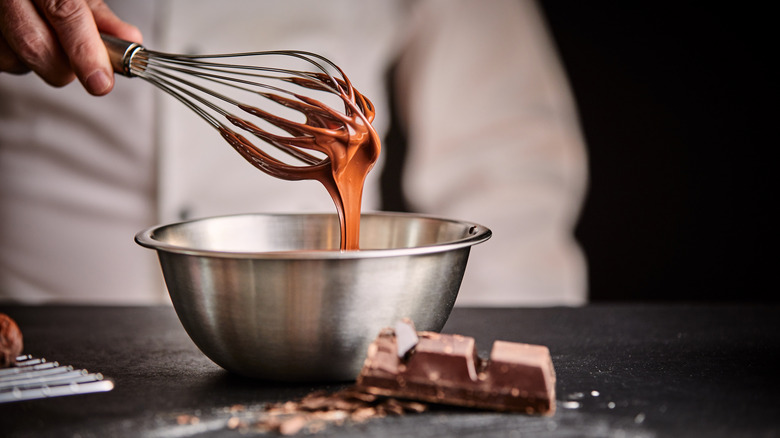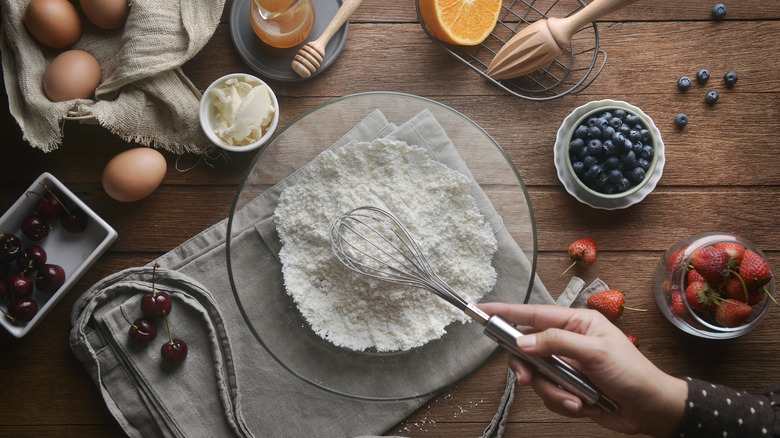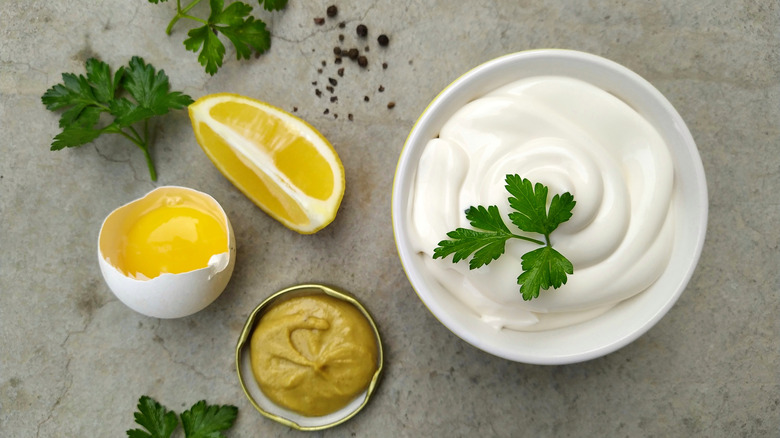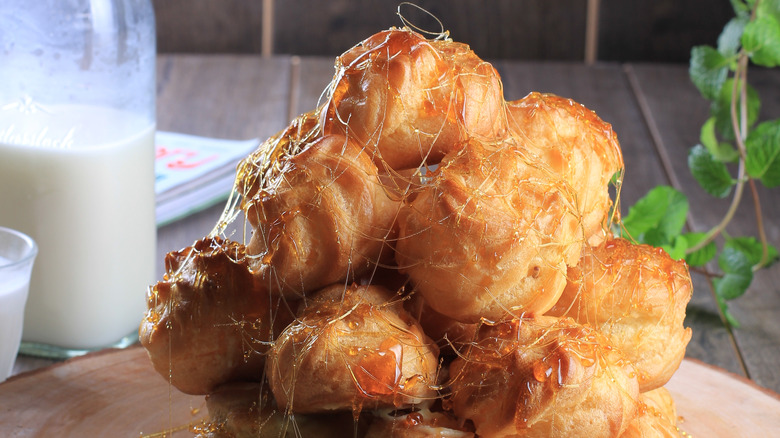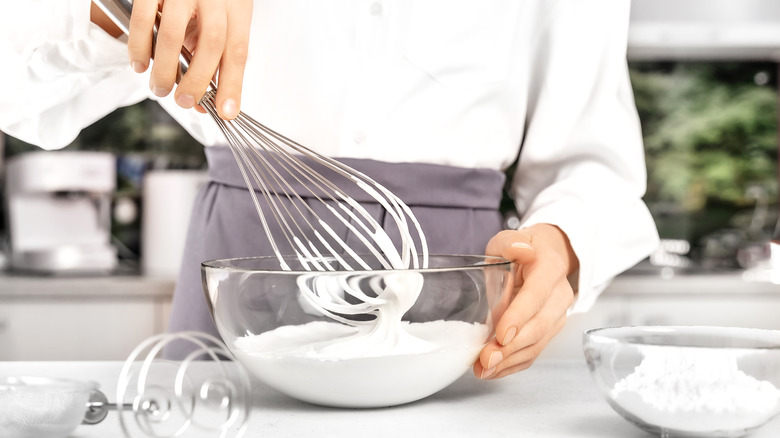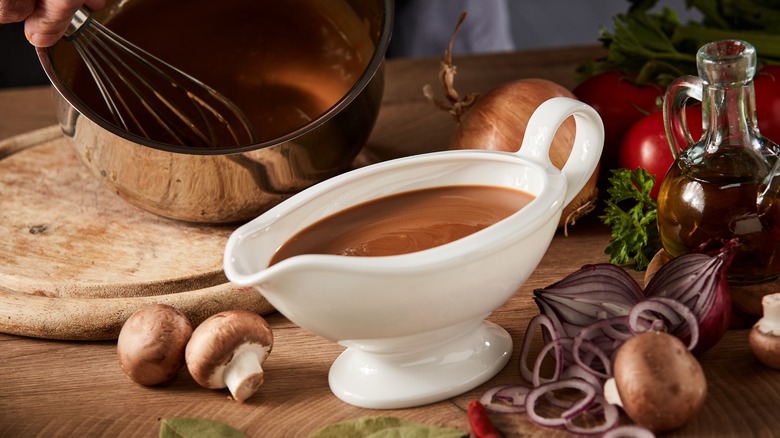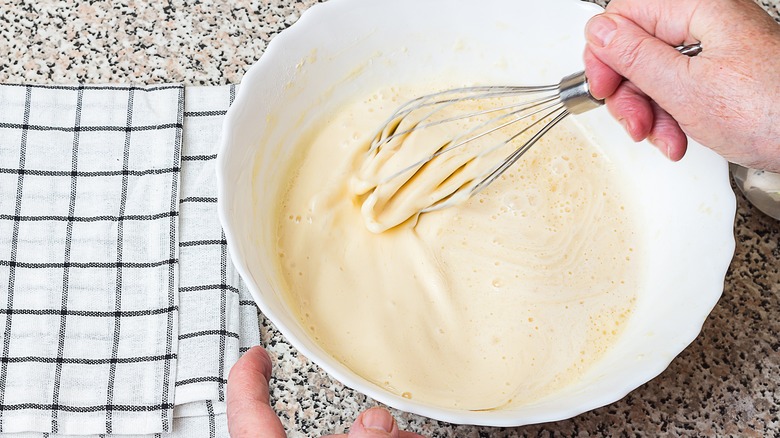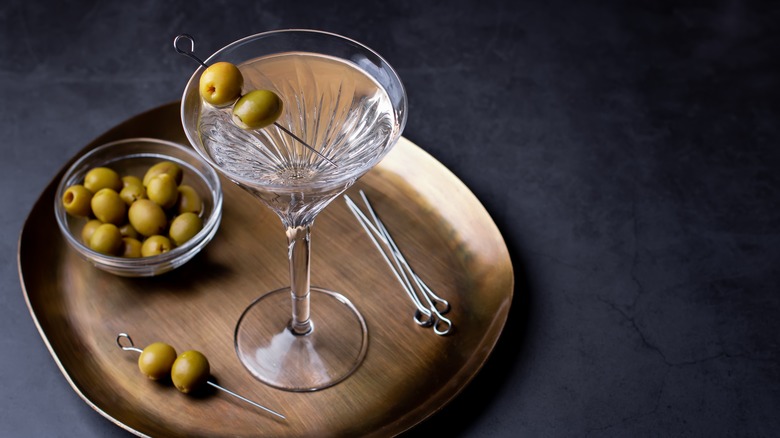The Absolute Best Uses For Your Whisk
Right up there with spatulas and tongs, whisks are a kitchen tool that almost everyone has hanging out in one of their drawers. These handheld tools are requisite staples that most home cooks employ on a fairly regular basis, often used to mix ingredients, whip cream or sauces, aerate things like meringue or batter, and to ensure a fluffier flapjack or mousse. Though whisks come in a variety of different materials, such as wood or nylon, the most common whisks are metal with metal handles (via Good Food Stories). The balloon shape allows ingredients to easily sift through the open slots.
Considering its omnipresence in most households, a whisk might seem like a straightforward mixing device. But, it's surprisingly easy to misuse a whisk, or simply use the wrong kind of whisk, which is why it's important to plan ahead, shop around, and hone in on the right uses for your whisk. One major example is with scrambled eggs; a whisk is the default tool for a lot of people. However, contrary to popular assumptions, whisking scrambled eggs runs the risk of over-beating the eggs, resulting in a rubbery finished product. In this case, a fork is a better bet, or even something like chopsticks. But while whisks might not be ideal for certain ingredients and techniques, they're perfectly employed for other kitchen uses. Here are the absolute best uses for your whisk.
Whisk flour instead of sifting
One of the most popular go-to uses for a whisk is mixing together dry ingredients for a pastry or dessert. When combining dry ingredients for a baking recipe, like flour, baking powder, baking soda, and salt, you can use a whisk in place of a sifter — in case you don't have a sifter on hand. Not only does it get the job done by evenly combining the dry ingredients by whisking them together in a bowl, but it also helps aerate everything in the same way that sifting would.
Adding air to dry ingredients like this is an important step in any baking recipe, in that it'll add extra oxygen to help the finished product come out light, fluffy, and moist (via Baking Kneads). Whisks are handy for blending dry ingredients, but the kitchen tool is also useful throughout many baking processes, including mixing wet ingredients and batters for something like strawberry cobbler.
Use a whisk for homemade mayonnaise
For emulsifications, aka the process of slowly combining two liquids that don't normally blend together (like oil and water), whisks get the job done. Mayonnaise is a prime example of a popular emulsified condiment. Taking a DIY approach and mixing by hand (rather than using an electric blender) will ensure a tasty product with a consistent texture. It'll likely have a different consistency than if you were to whip up some mayo in a machine. But, mixing eggs with vinegar or lemon juice, oil, and salt (and maybe a dash of mustard, if you'd like) by hand gives you more control over the process, so you don't overbeat the mixture, or create a splattered mess.
One recipe for homemade mayo: You just whisk together egg yolks and salt in a bowl, then start incorporating oil a few drops at a time, whisking constantly until the oil is all fully combined, before adding lemon juice and water. The whisk makes it that simple.
Make spun sugar
Whisks aren't only good for mixing ingredients together. In some cases, they can be just as useful with something as dainty as drizzling a single ingredient for a garnish or showpiece. Spun sugar is a show-stopping technique that involves melting sugar into a malleable texture, then simply drizzling it into different fine shapes and patterns (via A Beautiful Plate).
Even if you're not planning on making something as technical as, say, a recipe for croquembouche, spun sugar is a fun way to add a little pizzazz to all kinds of sweets, and a whisk is the perfect tool for dipping into the melted sugar and letting it drizzle off the ends in whatever shapes you'd like. Sure, it's not a quick process, and one that requires caution when working with a high-heat ingredient like melted sugar, but as long as you're patient and careful, a whisk can really bring the wow factor to your next dinner party.
Whipping homemade whipped cream
One of the most classic uses for a whisk is handmade whipped cream. While store bought is convenient, nothing compares to the fresh flavor and texture of a fluffy batch you whipped up yourself. Whipped cream adds that extra oomph to a slice of pie or a scoop of ice cream — especially if you add a special ingredient like bitters in homemade whipped cream.
Fortunately, a whisk makes it super easy. As long as you have heavy cream (or heavy whipping cream), vanilla extract, and granulated sugar on hand, you'll be good to go for whipped cream. Just pour cream into a bowl, add the rest of the ingredients, and start whisking away until it's reached a fluffy texture known as medium peaks (via Fine Cooking), a term used for whipped cream that is firm enough in texture, yet when you pull the whisk away, the tips of the cream will curl over.
Making gravy
A huge asset of a whisk, and what sets it apart from something like a spoon, is how the interwoven wires are specifically spaced and designed to eliminate lumps. This design ensures the finished product — be it a sauce, frosting, or condiment — is smooth and even. A perfect example of this is good, old-fashioned gravy.
Aside from something like a recipe for sausage gravy, where meaty morsels are a desired part of the finished product, most gravies should be velvety smooth and lump free. Let's just say that lumps don't really have a place at the Thanksgiving table. A classic brown gravy made with broth, butter, flour, and spices is the perfect sauce for slathering over a bowl of mashed potatoes. A whisk will ensure there isn't any residual clumping as you stir and cook everything together (via The Toasty Kitchen). It's precise and tedious, but as long as you're diligent in your whisking throughout the low-and-slow cooking, you'll be rewarded with gravy riches.
Emulsifying vinaigrette
When it comes to emulsifying condiments and sauces, whisks are the MVP of the kitchen. By rigorously stirring liquids together in a steady stream, with a tool that allows for even aeration, it's the dream tool for a good dressing. The same is certainly true of one of the most quintessential emulsifications, a classic vinaigrette made with vinegar and olive oil (and whatever additional seasonings and spices you feel like adding to jazz up your salad).
There are plenty of alternate ways to make a vinaigrette, including our recipe for salad dressing in a jar, but whisking is the most traditional — and a method that provides more control over the emulsification process while allowing you to drizzle the oil in a gentle, steady stream (via Williams Sonoma). Sure, you could hit the fast-forward button and just whirl everything together in an electric mixer, but whisking allows you to nail the exact texture and ratios while seasoning to taste along the way.
Mixing pancake batter
Seeing as whisking is an important step in aerating ingredients and removing lumps from sauces or gravies, that clearly makes the tool a win-win when it's time for breakfast. For made-from-scratch pancakes, whisking the batter is a surefire way to guarantee your pancakes are lump-free (it wouldn't be ideal to bite into a nugget of raw flour in a flapjack), as well as light and fluffy. And that's all thanks to the aeration from rigorous whisking when stirring up the pancake batter in a bowl.
Pancake batter is also a good example of how whisking provides more control over the mixing process than an electric mixer, which runs the risk of over-mixing the batter and resulting in denser, chewier pancakes. And if you really want your pancakes to be extra fluffy, you can add mayonnaise — another ingredient commonly made with a whisk, incidentally — to your batter too. Of course, pancakes aren't the only breakfast foods that benefit from a good whisking: The tool is just as convenient in a recipe for buttermilk Belgian waffles.
Stirring cocktails
While most folks turn to whisks for batters, sauces, and vinaigrettes, this kitchen tool is also useful for drinks. It turns out, with the right equipment, they're just as handy behind the home bar, especially when stirring a well-balanced cocktail. Unlike standard whisks, which are larger and broader in a "balloon" shape, cocktail whisks are specialty items that are smaller overall with a longer, thinner head and a narrow wire top that can easily fit to stir liquids at the bottom of a Collins or highball glass.
These smaller, daintier whisks are great for bartenders to gently stir drinks in a glass or a larger cocktail shaker (via Utensil.org) without adding the excessive aeration that might come from shaking all the ingredients. So, when you're making a stirred cocktail like a Negroni or a martini, give a cocktail whisk a try, and marvel at the James Bond-worthy smoothness.
